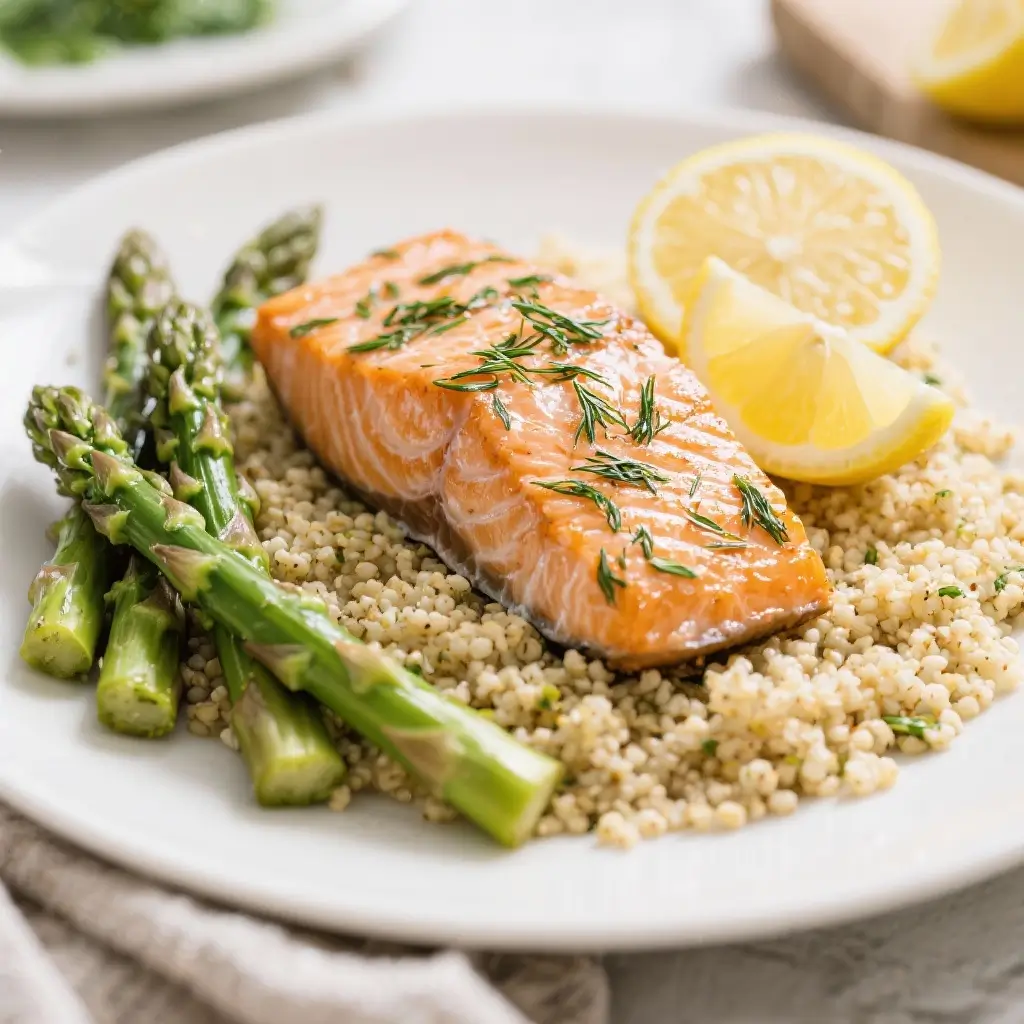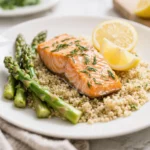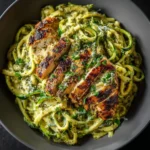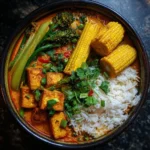Lemon Dill Salmon with Couscous & Asparagus
The History
The origins of Lemon Dill Salmon can be traced back to the coastal regions of Scandinavia and the Mediterranean, where fresh salmon has long been a dietary staple. In Nordic countries like Norway and Sweden, dill is a traditional herb used extensively in preserving and flavoring fish—think gravlax or pickled herring. The bright acidity of lemon complements the earthy freshness of dill, creating a timeless pairing that transcends borders. Over time, this flavor profile made its way into modern American and European kitchens, where it evolved into a beloved weeknight favorite.
Meanwhile, couscous—a North African semolina-based grain—originates from the Maghreb region (Morocco, Algeria, Tunisia) and has been a culinary cornerstone for centuries. Traditionally hand-rolled and steamed in a keskes, couscous was historically served during festive gatherings and family meals. Its light, fluffy texture makes it an ideal base for absorbing bold flavors. When paired with roasted or steamed vegetables like asparagus and rich, flaky salmon, couscous transforms a simple meal into something elegant and nourishing.
This dish—Lemon Dill Salmon with Couscous & Asparagus—represents a beautiful fusion of global traditions: the Nordic love for herbed salmon, the Mediterranean zest for citrus, and the North African artistry of grain preparation. It’s no surprise that this recipe has become a go-to for health-conscious food lovers, busy professionals, and home chefs seeking both flavor and balance on a single plate.
Ingredients Breakdown
The magic of this dish lies in the harmony of its ingredients, each contributing not only to taste but also to nutrition and texture. Let’s take a closer look at what goes into making this meal a standout:
- Fresh Salmon Fillets: Rich in omega-3 fatty acids, high-quality protein, and essential vitamins like B12 and D, salmon forms the centerpiece of this dish. Opt for wild-caught if possible, as it tends to have a superior flavor profile and lower environmental impact.
- Fresh Lemon: Provides a vibrant, zesty tang. Both the juice and zest are used to enhance the marinade and finish the dish with brightness. Lemons are packed with vitamin C and antioxidants.
- Fresh Dill: A fragrant herb with feathery green leaves, dill adds a slightly sweet, grassy note that pairs perfectly with seafood. It also contains anti-inflammatory properties and digestive benefits.
- Couscous: Technically a type of pasta made from durum wheat semolina, couscous cooks quickly and expands into fluffy, tender granules. It acts as a neutral canvas for the other bold flavors while offering complex carbohydrates for sustained energy.
- Asparagus: A springtime favorite, asparagus brings a crisp-tender bite and earthy-sweet flavor. It’s loaded with fiber, folate, and vitamins A, C, and K. Choose firm, bright green stalks with tightly closed tips.
- Extra Virgin Olive Oil: Used for roasting asparagus and drizzling over finished dishes, EVOO adds heart-healthy monounsaturated fats and polyphenols. It helps carry flavors and enhances nutrient absorption.
- Garlic: Minced fresh garlic infuses the salmon and couscous with aromatic depth and has natural antimicrobial and immune-boosting qualities.
- Vegetable or Chicken Broth: Replaces water when cooking couscous for a richer, more savory base. Using broth elevates the overall umami of the dish.
- Salt and Black Pepper: Essential seasonings that balance and round out all the components.
- Optional Additions: Red onion, cherry tomatoes, crumbled feta, pine nuts, or grated Parmesan can be added for extra layers of flavor and texture.
Step-by-Step Recipe
- Preheat the Oven: Begin by preheating your oven to 400°F (200°C). This ensures even roasting of the asparagus and prepares the environment for baking the salmon gently without drying it out.
- Prepare the Asparagus: Wash 1 bunch of asparagus and trim off the woody ends. Arrange the spears on a large baking sheet. Drizzle with 2 tablespoons of olive oil, the juice of half a lemon, 1 minced garlic clove, salt, and freshly ground black pepper. Toss well to coat evenly. Spread in a single layer and roast for 12–15 minutes, until tender-crisp and lightly caramelized. Flip halfway through for even browning.
- Season the Salmon: While the asparagus roasts, pat 4 salmon fillets (about 6 oz each) dry with paper towels. Place them skin-side down on a parchment-lined baking sheet. Season lightly with salt and pepper. In a small bowl, mix the zest of one lemon, 2 tablespoons fresh lemon juice, 1 tablespoon olive oil, 1 minced garlic clove, and 2 tablespoons chopped fresh dill. Spoon this mixture evenly over the top of each fillet, spreading it gently to cover the surface.
- Bake the Salmon: Bake the salmon in the preheated oven for 12–15 minutes, depending on thickness. The internal temperature should reach 145°F (63°C), and the flesh should flake easily with a fork. For extra moisture, you can loosely tent the salmon with foil during baking.
- Cook the Couscous: In a medium saucepan, bring 1 ¼ cups of vegetable or chicken broth to a boil. Stir in 1 cup of couscous, remove from heat, cover, and let sit for 5 minutes. After resting, fluff with a fork. Stir in 1 tablespoon of olive oil, 1 teaspoon of lemon zest, 1 tablespoon of fresh dill, and a pinch of salt. For added richness, mix in a tablespoon of butter or a sprinkle of feta cheese.
- Final Assembly: Divide the fluffy lemon-dill couscous among four plates. Top each portion with a roasted salmon fillet and a generous helping of lemon-garlic asparagus. Drizzle with a touch more olive oil or a squeeze of fresh lemon juice if desired. Garnish with additional chopped dill and lemon slices for presentation.
Tips
- Don’t Overcook the Salmon: Salmon continues to cook slightly after removal from the oven due to residual heat. Take it out when it’s just opaque in the center to avoid dryness.
- Use Fresh Herbs: While dried dill can work in a pinch, fresh dill offers a far superior aroma and flavor. Store leftover dill in a glass of water in the fridge, like a bouquet, to extend freshness.
- Toast the Couscous (Optional): For a nuttier flavor, toast the dry couscous in a skillet with a little olive oil before adding hot broth. This enhances its depth and complexity.
- Uniform Asparagus Stems: Try to select asparagus spears of similar thickness so they cook evenly. If using thicker stalks, consider peeling the lower half for tenderness.
- Marinate the Salmon Briefly: Even 10–15 minutes of marinating the salmon in the lemon-dill mixture will deepen the flavor. Avoid longer than 30 minutes, as the acid in lemon juice can start to “cook” the fish (ceviche-style).
- Double the Recipe: This dish reheats beautifully. Make extra for meal prep—store components separately and reheat gently in the microwave or oven.
- Parchment Paper or Foil: Lining your baking sheet makes cleanup effortless and prevents sticking. Parchment is preferred for non-stick safety and eco-friendliness.
Variations and Customizations
This recipe is incredibly versatile and welcomes creative tweaks based on dietary preferences, seasonal availability, or cultural influences:
- Gluten-Free Option: Replace couscous with quinoa, cauliflower rice, or millet. All absorb flavors well and provide a wholesome, gluten-free alternative.
- Dairy-Free & Vegan Twist: Use plant-based butter or omit fat enhancers. Replace salmon with grilled tofu or tempeh marinated in the same lemon-dill mixture for a vegan version.
- Spicy Kick: Add red pepper flakes to the salmon marinade or sprinkle harissa over the finished dish for a North African flair.
- Mediterranean Style: Mix chopped cucumber, cherry tomatoes, Kalamata olives, and red onion into the couscous. Finish with crumbled feta and a drizzle of tzatziki or Greek yogurt.
- Herb Swaps: Try tarragon, parsley, chives, or basil instead of dill for different herbal notes. Tarragon, in particular, pairs beautifully with salmon and lemon.
- Citrus Variations: Substitute lemon with lime or orange for a sweeter or more tropical twist. Blood orange zest adds a stunning pop of color and subtle berry-like sweetness.
- Grilled Version: Instead of baking, grill the salmon on a well-oiled griddle or cedar plank for a smoky flavor. Grill the asparagus too for charred edges and enhanced taste.
- Creamy Addition: Stir a spoonful of Greek yogurt or sour cream into the couscous along with the dill for a creamy texture and cooling contrast.
Health Considerations and Nutritional Value
Lemon Dill Salmon with Couscous & Asparagus isn’t just delicious—it’s a powerhouse of nutrients designed to support overall wellness.
Nutritional Highlights (per serving, approximate):
- Calories: ~450–500 kcal
- Protein: 30–35g (excellent source from salmon)
- Fat: 20–25g (mostly heart-healthy unsaturated fats from salmon and olive oil)
- Omega-3 Fatty Acids: 2,000–3,000mg (supports brain, heart, and joint health)
- Carbohydrates: 35–40g (primarily from whole grain or enriched couscous)
- Fiber: 6–8g (from asparagus and whole grain options)
- Vitamin D: High (especially important for bone and immune health)
- Vitamin C: From lemon and asparagus—supports immunity and collagen production
- Folate, Vitamin K, Iron, Magnesium: Present in meaningful amounts from vegetables and grains
Health Benefits:
- Heart Health: Omega-3s in salmon reduce inflammation and lower triglycerides, reducing risk of cardiovascular disease.
- Digestive Support: Fiber from asparagus and whole grains promotes gut motility and healthy microbiome balance.
- Weight Management: High protein and fiber content increase satiety, helping control appetite and prevent overeating.
- Anti-Aging Properties: Antioxidants in lemon, olive oil, and vegetables combat oxidative stress and support skin health.
- Bone Strength: Asparagus and salmon contribute vitamin K and calcium-supporting nutrients crucial for skeletal integrity.
Dietary Notes:
- Kosher/Halal: Ensure salmon is certified if following religious dietary laws.
- Pescatarian-Friendly: Perfect for those who eat fish but avoid meat.
- Low-Sodium Option: Use low-sodium broth and limit added salt; rely on herbs and citrus for flavor.
- Allergens: Contains fish and wheat (unless substituted). Serve in a controlled environment if allergies are a concern.
Ingredients
- 4 (6 oz) fresh salmon fillets, skin-on or skinless
- 2 tablespoons extra virgin olive oil (divided)
- Zest and juice of 1 large lemon (divided)
- 3 cloves garlic, minced (divided)
- ¼ cup fresh dill, finely chopped (plus extra for garnish)
- Salt and freshly ground black pepper, to taste
- 1 bunch asparagus, trimmed and halved if needed
- 1 ¼ cups low-sodium vegetable or chicken broth
- 1 cup couscous (regular or whole wheat)
- 1 tablespoon unsalted butter or olive oil (optional, for couscous)
- Optional: crumbled feta, pine nuts, cherry tomatoes, or lemon slices for garnish
Directions
- Preheat oven to 400°F (200°C). Line two baking sheets with parchment paper.
- On one baking sheet, arrange asparagus. Drizzle with 1 tablespoon olive oil, juice of half the lemon, 1 clove minced garlic, salt, and pepper. Toss to coat and spread in a single layer. Roast for 12–15 minutes, flipping halfway, until tender and lightly browned.
- In a small bowl, combine lemon zest, 1 tablespoon lemon juice, 1 tablespoon olive oil, 1 clove minced garlic, 2 tablespoons dill, salt, and pepper. Set aside.
- Place salmon fillets on the second baking sheet, skin-side down. Pat dry and season lightly with salt and pepper. Spoon the lemon-dill mixture evenly over the fillets.
- Bake salmon for 12–15 minutes, until the internal temperature reaches 145°F and the flesh flakes easily.
- While proteins cook, bring broth to a boil in a saucepan. Stir in couscous, cover, remove from heat, and let sit 5 minutes. Fluff with a fork and stir in remaining lemon zest, 1 clove garlic, 1 tablespoon dill, butter (if using), salt, and pepper.
- To serve, divide couscous among plates. Top with salmon and roasted asparagus. Garnish with extra dill, lemon slices, and optional toppings like feta or pine nuts.
- Enjoy immediately while warm!
FAQ
Can I use frozen salmon?
Yes, but thaw it slowly in the refrigerator overnight for best texture. Never cook frozen salmon directly unless specified by packaging instructions, as it may cook unevenly.
How do I store leftovers?
Store components separately in airtight containers in the refrigerator for up to 3 days. Reheat salmon gently in the oven at 300°F to prevent drying, or enjoy cold in salads.
Can I make this ahead of time?
Absolutely! Roast asparagus and cook couscous a few hours in advance. Marinate salmon and refrigerate. Bake everything just before serving for optimal freshness.
Is this recipe kid-friendly?
Yes! Many children enjoy the mild, buttery taste of salmon when paired with lemon and herbs. Serve with a side of applesauce or yogurt dip to ease picky eaters into trying new foods.
What wine pairs well with this dish?
A crisp Sauvignon Blanc, Pinot Grigio, or unoaked Chardonnay complements the citrus and herbal notes beautifully. For red lovers, a light Pinot Noir works well too.
Can I air fry the salmon?
Yes! Air fry at 375°F for 8–10 minutes, depending on thickness. Check frequently to avoid overcooking.
Why is my couscous mushy?
This usually happens from using too much liquid or not letting it rest covered. Stick to a 1:1.25 ratio of couscous to liquid and always allow 5 minutes of steaming off the heat.
Summary
Lemon Dill Salmon with Couscous & Asparagus is a nutritious, flavorful, and elegant dish that brings together the best of Nordic, Mediterranean, and North African culinary traditions. Perfect for weeknights or weekend dinners, it balances rich omega-3s, fiber-rich veggies, and wholesome grains in one satisfying plate.










